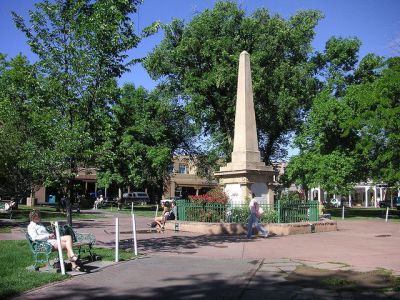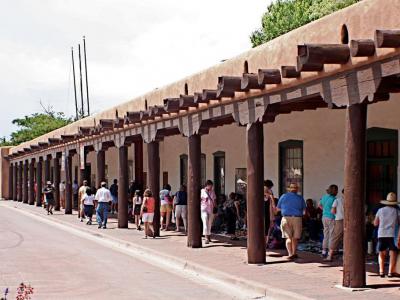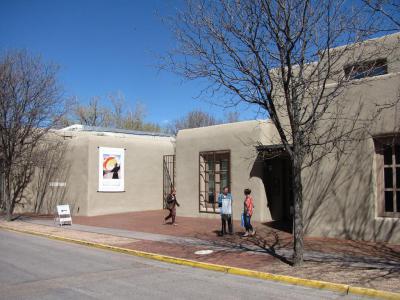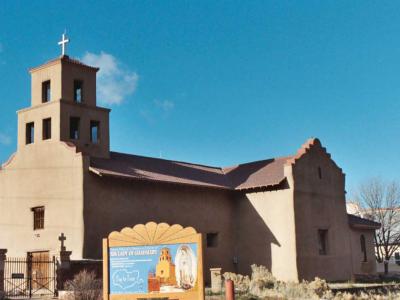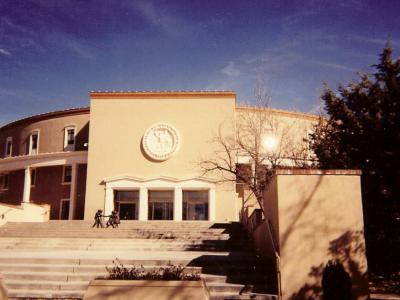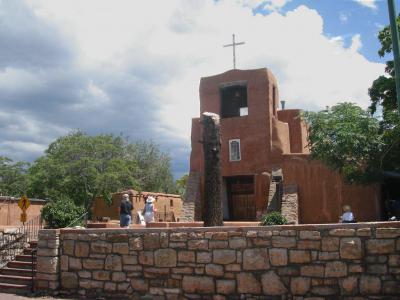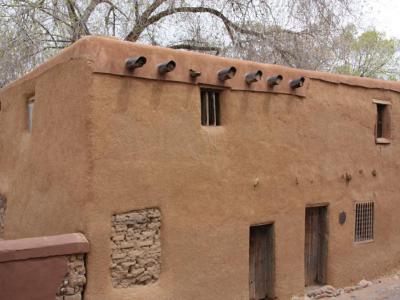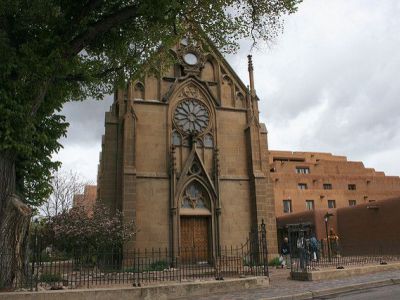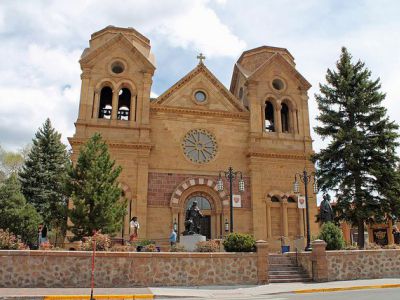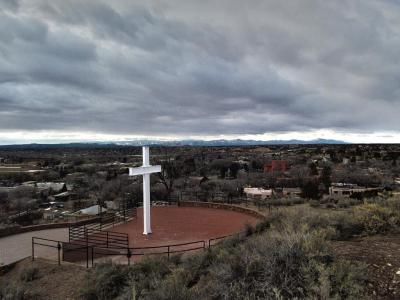
Santa Fe Introduction Walking Tour (Self Guided), Santa Fe
Santa Fe's full name is La Villa Real de la Santa Fe de San Francisco de Asis, or "The Royal Town of the Holy Faith of Saint Francis of Assisi." Thankfully, everyone sticks with "Santa Fe" for simplicity's sake.
The area has been settled for several thousand years, first by the native Puebloan cultures. The Tewa people called the town Ogha Po'oge , which roughly translated to "White Shell Water Place." The Santa Fe River, running through the center of town, was the primary draw for settlers. Until the 1700s, the river had year-round water flow. Its flow is now only seasonal, and it's considered one of the country's most endangered rivers.
Spain's first effort to colonize the area came in 1598. Governor Juan de Oñate created a capitol north of present-day Santa Fe. The Spanish government eventually expelled De Oñate for cruelty to the indigenous people, and the next governor, Don Pedro de Peralta, settled in Santa Fe. In 1680, the Pueblo cultures banded together in revolt, and they ruled the area until 1692 when the Spanish reconquered the area. The US claimed the territory from Mexico in 1846, but it was not until 1912 that New Mexico became the 47th state in the Union.
Santa Fe is a beautiful town full of historical wonder. Influences from indigenous Indian cultures abound, from the adobe Puebloan-style buildings to the crafts sold along the Plaza. You'll also find European influences in many places, none so evident as at the Gothic-style Loretto Chapel. The Palace of Governors and New Mexico History Museums provide a great starting point to learn about the many different influences in the area. Follow this self-guided tour to visit the most important attractions in historic Santa Fe.
The area has been settled for several thousand years, first by the native Puebloan cultures. The Tewa people called the town Ogha Po'oge , which roughly translated to "White Shell Water Place." The Santa Fe River, running through the center of town, was the primary draw for settlers. Until the 1700s, the river had year-round water flow. Its flow is now only seasonal, and it's considered one of the country's most endangered rivers.
Spain's first effort to colonize the area came in 1598. Governor Juan de Oñate created a capitol north of present-day Santa Fe. The Spanish government eventually expelled De Oñate for cruelty to the indigenous people, and the next governor, Don Pedro de Peralta, settled in Santa Fe. In 1680, the Pueblo cultures banded together in revolt, and they ruled the area until 1692 when the Spanish reconquered the area. The US claimed the territory from Mexico in 1846, but it was not until 1912 that New Mexico became the 47th state in the Union.
Santa Fe is a beautiful town full of historical wonder. Influences from indigenous Indian cultures abound, from the adobe Puebloan-style buildings to the crafts sold along the Plaza. You'll also find European influences in many places, none so evident as at the Gothic-style Loretto Chapel. The Palace of Governors and New Mexico History Museums provide a great starting point to learn about the many different influences in the area. Follow this self-guided tour to visit the most important attractions in historic Santa Fe.
How it works: Download the app "GPSmyCity: Walks in 1K+ Cities" from Apple App Store or Google Play Store to your mobile phone or tablet. The app turns your mobile device into a personal tour guide and its built-in GPS navigation functions guide you from one tour stop to next. The app works offline, so no data plan is needed when traveling abroad.
Santa Fe Introduction Walking Tour Map
Guide Name: Santa Fe Introduction Walking Tour
Guide Location: USA » Santa Fe (See other walking tours in Santa Fe)
Guide Type: Self-guided Walking Tour (Sightseeing)
# of Attractions: 10
Tour Duration: 2 Hour(s)
Travel Distance: 3.4 Km or 2.1 Miles
Author: sabrina
Sight(s) Featured in This Guide:
Guide Location: USA » Santa Fe (See other walking tours in Santa Fe)
Guide Type: Self-guided Walking Tour (Sightseeing)
# of Attractions: 10
Tour Duration: 2 Hour(s)
Travel Distance: 3.4 Km or 2.1 Miles
Author: sabrina
Sight(s) Featured in This Guide:
- Santa Fe Plaza
- Palace of the Governors
- Georgia O'Keeffe Museum
- Santuario de Guadalupe (Shrine of Our Lady of Guadalupe)
- New Mexico State Capitol
- San Miguel Mission (Oldest Church in the US)
- Oldest House Museum (De Vargas Street House)
- Loretto Chapel
- Cathedral Basilica of St. Francis of Assisi
- Cross of the Martyrs
1) Santa Fe Plaza (must see)
The center of Sante Fe's life for more than 400 years, the Plaza is bordered by Washington, Palace, and Lincoln Avenues and San Fransisco Street. It's a meeting place and a shopping center. Throughout the year, you'll find significant events hosted here. There's always something going on—the Plaza is really the heart and soul of the city.
The Plaza itself is a National Historic Landmark; indeed, there's a large marker in the center of the Plaza. But the Plaza is much more important than that. In the tradition of Spanish-American colonial cities, the city was built around the Plaza since around 1610. The original Plaza was built as a fort, surrounded by large walls that enclosed the governor's palace. It served as the social and economic center of town where colonists and Pueblo Indians could trade goods.
The Plaza has also served as the terminus for trade routes over the years. As the center of the city, it only makes sense that roads lead there. Some of those famous roads included El Camino Real from Mexico City and the Santa Fe Trail from Missouri.
Why You Should Visit:
It's hard to imagine a trip to Santa Fe without stopping by the Plaza for one reason or another. Many come to see the Palace of the Governors or the historic buildings. Others come to shop and dine. There are also many excellent arts, music, and cultural festivals offered throughout the year that are worth stopping for.
Many of Santa Fe's most significant attractions are walking distance from the Plaza. The Plaza is the perfect spot to use as your base for exploring. You can come back throughout your day, either to relax in the park or to grab a bite to eat.
Tips:
Every September, the Plaza hosts the Fiesta de Santa Fe. The Fiesta has been held for more than 300 years. In 1712, the first Fiesta council created a proclamation that there should always be a celebration of the 1692 reconquest of New Mexico by General Don Diego de Vargas. The Fiesta has changed over the years but still includes historical reenactments, Catholic mass services, arts, crafts, food booths, and lots of live music and dancing.
For a closer look at the history of the city and the state, check out the adjacent New Mexico History Museum and the Palace of the Governors.
The Plaza itself is a National Historic Landmark; indeed, there's a large marker in the center of the Plaza. But the Plaza is much more important than that. In the tradition of Spanish-American colonial cities, the city was built around the Plaza since around 1610. The original Plaza was built as a fort, surrounded by large walls that enclosed the governor's palace. It served as the social and economic center of town where colonists and Pueblo Indians could trade goods.
The Plaza has also served as the terminus for trade routes over the years. As the center of the city, it only makes sense that roads lead there. Some of those famous roads included El Camino Real from Mexico City and the Santa Fe Trail from Missouri.
Why You Should Visit:
It's hard to imagine a trip to Santa Fe without stopping by the Plaza for one reason or another. Many come to see the Palace of the Governors or the historic buildings. Others come to shop and dine. There are also many excellent arts, music, and cultural festivals offered throughout the year that are worth stopping for.
Many of Santa Fe's most significant attractions are walking distance from the Plaza. The Plaza is the perfect spot to use as your base for exploring. You can come back throughout your day, either to relax in the park or to grab a bite to eat.
Tips:
Every September, the Plaza hosts the Fiesta de Santa Fe. The Fiesta has been held for more than 300 years. In 1712, the first Fiesta council created a proclamation that there should always be a celebration of the 1692 reconquest of New Mexico by General Don Diego de Vargas. The Fiesta has changed over the years but still includes historical reenactments, Catholic mass services, arts, crafts, food booths, and lots of live music and dancing.
For a closer look at the history of the city and the state, check out the adjacent New Mexico History Museum and the Palace of the Governors.
2) Palace of the Governors (must see)
Located on the north side of the Santa Fe Plaza, the Palace of the Governors is the oldest continuously occupied building in the United States made by European settlers. It was erected by order of the Spanish Crown in 1610. It was the administrative center of the colony.
The building itself has changed dramatically over the years. As you see it today, it was designated as the home of the Museum of New Mexico in 1909. At that time, the Palace was renovated using Spanish-Pueblo Revival styles so prevalent in the state. Through Spanish colonial life, the Pueblo Revolt, Mexican rule in the 1800s, years as an American territory, and finally as an American state, the Palace has remained the center of Sante Fean life.
The Palace is part of the New Mexico History Museum complex, which includes the building behind the Palace as well. Inside you will find history exhibits and displays about the Palace and the stories of the people who settled the area.
Why You Should Visit:
Along the block-long portal that faces the Plaza, you'll often find many Native American artists selling handmade traditional jewelry and crafts.
As the primary state history museum, the site holds the most extensive collection of objects and photographs documenting the region's history. For example, the Segesser Hide Paintings are rare hide paintings of Spanish colonial battles, circa the 1700s. The Ben Wittisk Collection features glass plate negatives and photographic prints from the late nineteenth century.
Tips:
Check into the downtown walking tours offered by the museum docents. There are also tours available of the museum and the Palace of the Governors.
With the tours and exhibits, give yourself several hours to soak in the entire experience at the Palace. And don't forget to check out the rest of the museum in the newer building.
The building itself has changed dramatically over the years. As you see it today, it was designated as the home of the Museum of New Mexico in 1909. At that time, the Palace was renovated using Spanish-Pueblo Revival styles so prevalent in the state. Through Spanish colonial life, the Pueblo Revolt, Mexican rule in the 1800s, years as an American territory, and finally as an American state, the Palace has remained the center of Sante Fean life.
The Palace is part of the New Mexico History Museum complex, which includes the building behind the Palace as well. Inside you will find history exhibits and displays about the Palace and the stories of the people who settled the area.
Why You Should Visit:
Along the block-long portal that faces the Plaza, you'll often find many Native American artists selling handmade traditional jewelry and crafts.
As the primary state history museum, the site holds the most extensive collection of objects and photographs documenting the region's history. For example, the Segesser Hide Paintings are rare hide paintings of Spanish colonial battles, circa the 1700s. The Ben Wittisk Collection features glass plate negatives and photographic prints from the late nineteenth century.
Tips:
Check into the downtown walking tours offered by the museum docents. There are also tours available of the museum and the Palace of the Governors.
With the tours and exhibits, give yourself several hours to soak in the entire experience at the Palace. And don't forget to check out the rest of the museum in the newer building.
3) Georgia O'Keeffe Museum (must see)
O'Keeffe is the most famous of the famous Santa Fe artists. The O'Keeffe Museum is a small gallery just a few blocks off Santa Fe Plaza, but it houses an incredible collection of the versatile artist's work. O'Keeffe's fame was built as early as the 1920s when she was known for being an independent female role model and a dynamic artist.
O'Keeffe was an internationally renown painter, often credited as the "Mother of American modernism." While she studied and trained out East, she visited the Southwest often and found much inspiration here. After 1929, she lived permanently in Abiquiú, a small village about an hour north of Santa Fe.
O'Keeffe is most known for her watercolor paintings of flowers and Southwest themes. She would collect rocks and bones from the desert, and she looked to the unique architecture found in the area for inspiration.
Why You Should Visit:
More than just a collection of her works, the Georgia O'Keeffe Museum is part of the O'Keeffe Foundation, a non-profit set up from her estate's assets. Archival materials, photographs, many pieces of her work, and her Abiquiú home and studio are now part of the museum.
Tips:
Don't miss the introductory movie chronicling O'Keeffe's life and artwork when you first enter the museum.
Check out the museum's website for online programs, including watercolor classes and history programs.
If visiting the museum has inspired you to learn more about Georgia O'Keeffe, consider booking a tour of her historic adobe home and studio overlooking the Chama River Valley in Abiquiú.
O'Keeffe was an internationally renown painter, often credited as the "Mother of American modernism." While she studied and trained out East, she visited the Southwest often and found much inspiration here. After 1929, she lived permanently in Abiquiú, a small village about an hour north of Santa Fe.
O'Keeffe is most known for her watercolor paintings of flowers and Southwest themes. She would collect rocks and bones from the desert, and she looked to the unique architecture found in the area for inspiration.
Why You Should Visit:
More than just a collection of her works, the Georgia O'Keeffe Museum is part of the O'Keeffe Foundation, a non-profit set up from her estate's assets. Archival materials, photographs, many pieces of her work, and her Abiquiú home and studio are now part of the museum.
Tips:
Don't miss the introductory movie chronicling O'Keeffe's life and artwork when you first enter the museum.
Check out the museum's website for online programs, including watercolor classes and history programs.
If visiting the museum has inspired you to learn more about Georgia O'Keeffe, consider booking a tour of her historic adobe home and studio overlooking the Chama River Valley in Abiquiú.
4) Santuario de Guadalupe (Shrine of Our Lady of Guadalupe)
The 'Shrine of Our Lady of Guadalupe' was built in the 1770s–it's the oldest shrine in the United States dedicated to the Virgin of Guadalupe. It was built to commemorate Mary's apparitions in 1531 to the Aztec peasant Juan Diego of Tepeyac. The Shrine, situated near the Santa Fe Plaza near the river, was placed near the end of El Camino Real from Mexico City.
Our Lady of Guadalupe, or Nuestra Señora de Guadalupe, is a Catholic title for the Virgin Mary. According to Catholic accounts, the Virgin Mary appeared before a Mexican farmer in 1531 five times. She told him to seek out the archbishop and build a church in her honor. The archbishop, who was suspicious of Juan Diego's claims, asked him to return to the hill where he saw the Virgin and ask for proof. After relaying the message to the Virgin, Juan Diego found non-native Castillian roses blooming on the barren hills of Tepeyac. The Virgin also appeared before Juan Diego's brother on his deathbed, miraculously healing him. The archbishop was duly convinced.
The Virgin became the patron saint of Mexico and is thoroughly intertwined with modern-day Mexican Catholicism.
Today the Shrine serves as a history and art museum. The Archdiocese of Santa Fe's collection of Italian Renaissance paintings, Mexican baroque paintings, and Santos are on display. The star of the collection, however, is a large full-body image of Our Lady of Guadalupe depicting the 1531 apparition story.
Our Lady of Guadalupe, or Nuestra Señora de Guadalupe, is a Catholic title for the Virgin Mary. According to Catholic accounts, the Virgin Mary appeared before a Mexican farmer in 1531 five times. She told him to seek out the archbishop and build a church in her honor. The archbishop, who was suspicious of Juan Diego's claims, asked him to return to the hill where he saw the Virgin and ask for proof. After relaying the message to the Virgin, Juan Diego found non-native Castillian roses blooming on the barren hills of Tepeyac. The Virgin also appeared before Juan Diego's brother on his deathbed, miraculously healing him. The archbishop was duly convinced.
The Virgin became the patron saint of Mexico and is thoroughly intertwined with modern-day Mexican Catholicism.
Today the Shrine serves as a history and art museum. The Archdiocese of Santa Fe's collection of Italian Renaissance paintings, Mexican baroque paintings, and Santos are on display. The star of the collection, however, is a large full-body image of Our Lady of Guadalupe depicting the 1531 apparition story.
5) New Mexico State Capitol
Known as the Roundhouse, the state capitol building in Santa Fe is unique. It is built to resemble the state's ubiquitous Zia sun symbol. Viewed from above, the four entrance wings connect to the central circle, just like the symbol you see on the state flag.
The four-level capitol building revolves around a large central rotunda, which is finished in local Travertine marble with turquoise and brass mosaic inlays. The building is full of these intricate and beautiful details. Another example is the stained rotunda glass skylight, designed to look like Indian basket weaving. The first floor is actually below ground level and houses the Senate and House chambers, which are not open to the public. Viewing galleries on the second level allow visitors to view both chambers. The third and fourth floors house committee rooms and offices, including the governor's.
Around the capitol building, you'll find a six and a half-acre garden with more than 100 types of plants and statues of native Pueblo people. Throughout the building, you will also find the Capitol Art Foundation's collection, which includes many masterpieces by artists who live and work in New Mexico.
The current capitol building was built in 1966 and is the fifth building used as its government center. The first was the Palace of Governors, located in the Plaza downtown. The 1850 Capitol is now the federal courthouse, and the 1886 Capitol was destroyed by fire. The 1900 Capitol was renovated many times over the years and now houses the National Guard Military Museum.
The four-level capitol building revolves around a large central rotunda, which is finished in local Travertine marble with turquoise and brass mosaic inlays. The building is full of these intricate and beautiful details. Another example is the stained rotunda glass skylight, designed to look like Indian basket weaving. The first floor is actually below ground level and houses the Senate and House chambers, which are not open to the public. Viewing galleries on the second level allow visitors to view both chambers. The third and fourth floors house committee rooms and offices, including the governor's.
Around the capitol building, you'll find a six and a half-acre garden with more than 100 types of plants and statues of native Pueblo people. Throughout the building, you will also find the Capitol Art Foundation's collection, which includes many masterpieces by artists who live and work in New Mexico.
The current capitol building was built in 1966 and is the fifth building used as its government center. The first was the Palace of Governors, located in the Plaza downtown. The 1850 Capitol is now the federal courthouse, and the 1886 Capitol was destroyed by fire. The 1900 Capitol was renovated many times over the years and now houses the National Guard Military Museum.
6) San Miguel Mission (Oldest Church in the US) (must see)
Originally built around 1610 by Franciscan friars, the Mision de San Miguel is the oldest church in the United States and one of the oldest structures. It was the first church built in Santa Fe. The Spanish missionaries located the facility across the river in an area primarily inhabited by native people. Missionary work was a priority for the Spanish settlers, so they built the mission building before building their own church closer to the Plaza.
The San Miguel Mission has been rebuilt several times, so it is unclear precisely what extent of the mission is original. It is an adobe structure with clay walls that are about five feet thick. The stone buttresses were added in 1887 to help support the structure. The original church was likely slightly smaller, and while it has been rebuilt and updated from time to time, it remains on the same foundations.
Why You Should Visit:
Besides the church's beautiful architecture and historical significance, the building houses several pieces of artwork and history worth a visit. The reredos are wooded altar screens that date back to 1798. Between the screens, you'll see a wooden statue of St. Michael the Archangel, which came from Mexico in 1709 and has been in place here since at least 1776. There are many other paintings surrounding the reredos. You'll also find the original bell that hung in the tower before 1872. The bell's engraving indicates that it is from 1356, but historians think this is highly unlikely. Most probably, a casting defect changed the eight to appear like a three.
Tips:
The church is still in operation and offers Latin Mass at 3:00 p.m. and English Mass at 5:00 p.m. on Sundays. The chapel is open for visitors before and between Masses, and most other days from 10:00 a.m. to 4:00 p.m.
The San Miguel Mission has been rebuilt several times, so it is unclear precisely what extent of the mission is original. It is an adobe structure with clay walls that are about five feet thick. The stone buttresses were added in 1887 to help support the structure. The original church was likely slightly smaller, and while it has been rebuilt and updated from time to time, it remains on the same foundations.
Why You Should Visit:
Besides the church's beautiful architecture and historical significance, the building houses several pieces of artwork and history worth a visit. The reredos are wooded altar screens that date back to 1798. Between the screens, you'll see a wooden statue of St. Michael the Archangel, which came from Mexico in 1709 and has been in place here since at least 1776. There are many other paintings surrounding the reredos. You'll also find the original bell that hung in the tower before 1872. The bell's engraving indicates that it is from 1356, but historians think this is highly unlikely. Most probably, a casting defect changed the eight to appear like a three.
Tips:
The church is still in operation and offers Latin Mass at 3:00 p.m. and English Mass at 5:00 p.m. on Sundays. The chapel is open for visitors before and between Masses, and most other days from 10:00 a.m. to 4:00 p.m.
7) Oldest House Museum (De Vargas Street House)
The area across the river from the central town Plaza was known as the Barrio de Analco. It was settled by the working-class inhabitants of early Santa Fe, including Tlaxcaltec people who came to New Mexico with the Spanish in the early 1600s. The center of the settlement was the San Miguel Mission.
The "Oldest" House was part of this community, but some archaeologists believe that many parts of the home were part of an Analco pueblo that was already there. The actual construction date is unknown. Some clues in the structure suggest that it may be from the late 1700s. The original house was single-story, and the second story was added in the 1920s.
Regardless of the houses' precise origin story, the museum is on the US National Register of Historic Places. It is a cornerstone property in the Barrio De Analco Historic District, which contains six other buildings from the era. Years of calling it the "Oldest House" have become engrained in local lore and evidence from the property proves that vigas in the ceilings were cut between 1740 and 1767. Currently, Wikipedia lists the De Vargas Street House as the twelfth oldest post-European building in the US (outside of Puerto Rico), with a construction date of 1646.
The eastern portion of the house is rented as a curio shop. The western side is a living example of the types of buildings that once prevailed in Santa Fe. It has Indian and Spanish influences, with crude thick adobe walls, low-hung ceilings, and dirt floors.
Why You Should Visit:
The Oldest House Museum is worth a stop, especially if you're in the area to see the San Miguel Mission. It gives a good idea of what it would have been like to live in Santa Fe centuries ago. Tours are self-guided and free. The space is small, just two rooms and a gift shop.
Tips:
This is a quick stop best combined with other sites along the way. Don't miss the nearby San Miguel Mission.
The "Oldest" House was part of this community, but some archaeologists believe that many parts of the home were part of an Analco pueblo that was already there. The actual construction date is unknown. Some clues in the structure suggest that it may be from the late 1700s. The original house was single-story, and the second story was added in the 1920s.
Regardless of the houses' precise origin story, the museum is on the US National Register of Historic Places. It is a cornerstone property in the Barrio De Analco Historic District, which contains six other buildings from the era. Years of calling it the "Oldest House" have become engrained in local lore and evidence from the property proves that vigas in the ceilings were cut between 1740 and 1767. Currently, Wikipedia lists the De Vargas Street House as the twelfth oldest post-European building in the US (outside of Puerto Rico), with a construction date of 1646.
The eastern portion of the house is rented as a curio shop. The western side is a living example of the types of buildings that once prevailed in Santa Fe. It has Indian and Spanish influences, with crude thick adobe walls, low-hung ceilings, and dirt floors.
Why You Should Visit:
The Oldest House Museum is worth a stop, especially if you're in the area to see the San Miguel Mission. It gives a good idea of what it would have been like to live in Santa Fe centuries ago. Tours are self-guided and free. The space is small, just two rooms and a gift shop.
Tips:
This is a quick stop best combined with other sites along the way. Don't miss the nearby San Miguel Mission.
8) Loretto Chapel (must see)
Now a museum and wedding chapel, this former Roman Catholic church was commissioned in 1873. It was built by the Sisters of Loretto for their girls' school. French architects Antoine and Projectus Mouly based the design on the Gothic Revival-style Sainte-Chapelle in Paris. The building has the spires, buttresses, and stained glass that you'd expect from such a structure.
The centerpiece of the church, however, is the spiral staircase. Known as the Miraculous Stairs, they climb two full turns to the choir loft above. The stairs have no support structure or central pole, and they are held together only with glue and wood pegs. The stairs never fail to impress even modern carpenters who have access to modern tools and methods that the stair's creator couldn't even dream of.
According to the Sisters of Loretto, the choir loft and stairs were the last additions needed for the church, but the primary architect's death created problems. No one could find a solution for creating the loft in such a limited space, and so the nuns prayed to St. Joseph, the patron saint of carpenters, for nine days straight. On the ninth day, a mysterious stranger appeared and agreed to build the staircase. The man worked in solitude and disappeared after the staircase was completed. The sisters were certain it was a miracle.
Why You Should Visit:
The spiral staircase is sure to impress and inspire all visitors with its workmanship and history. You also won't want to miss the gorgeous adornments to the former church, including the stained glass rose window and many statues. The chapel was the first Gothic building built west of the Mississippi.
Tips:
Take the time to listen to the chapel's audiotape history, which will fill you in on the intriguing history of the chapel. The tape plays on a loop throughout the chapel.
The centerpiece of the church, however, is the spiral staircase. Known as the Miraculous Stairs, they climb two full turns to the choir loft above. The stairs have no support structure or central pole, and they are held together only with glue and wood pegs. The stairs never fail to impress even modern carpenters who have access to modern tools and methods that the stair's creator couldn't even dream of.
According to the Sisters of Loretto, the choir loft and stairs were the last additions needed for the church, but the primary architect's death created problems. No one could find a solution for creating the loft in such a limited space, and so the nuns prayed to St. Joseph, the patron saint of carpenters, for nine days straight. On the ninth day, a mysterious stranger appeared and agreed to build the staircase. The man worked in solitude and disappeared after the staircase was completed. The sisters were certain it was a miracle.
Why You Should Visit:
The spiral staircase is sure to impress and inspire all visitors with its workmanship and history. You also won't want to miss the gorgeous adornments to the former church, including the stained glass rose window and many statues. The chapel was the first Gothic building built west of the Mississippi.
Tips:
Take the time to listen to the chapel's audiotape history, which will fill you in on the intriguing history of the chapel. The tape plays on a loop throughout the chapel.
9) Cathedral Basilica of St. Francis of Assisi (must see)
Commonly referred to as Saint Francis Cathedral, this Roman Catholic cathedral is located downtown and is the home of the Archdiocese of Santa Fe. The current building was erected between 1869 and 1886 on the site of an older adobe church. The church's design stands in stark contrast with its surroundings, as it was built in the Romanesque Revival style. It features round arches with Corinthian columns and square towers. The church is also made from quarried limestone bricks instead of the adobe wall construction of Pueblo-style buildings.
The church is full of and surrounded by beautiful artwork. You'll find statues of St. Francis of Assisi, the patron saint of the diocese, along with statues of Saint Kateri and Jean-Baptiste Lamy. The Stations of the Cross Prayer Garden features 14 sculptures that show the hours leading up to Jesus' crucifixion.
Inside the church, you'll see ornate details like the engraved keystone and bronze doors. The rose window and the nave stained glass windows were imported from Clermont-Ferrand in France.
Why You Should Visit:
The church will transport you from Santa Fe to Europe with its Romanesque architecture. Interior tours feature captivating stain glasswork, while the outside gardens are sure to bring a peaceful respite from the busy city. Docents are happy to give personal tours to bring this church's history to life.
Tips:
Be sure to check the Cathedral's website for their Mass and Sacraments schedules. Don't miss the Native American Madonna, the oldest in the US.
The church is full of and surrounded by beautiful artwork. You'll find statues of St. Francis of Assisi, the patron saint of the diocese, along with statues of Saint Kateri and Jean-Baptiste Lamy. The Stations of the Cross Prayer Garden features 14 sculptures that show the hours leading up to Jesus' crucifixion.
Inside the church, you'll see ornate details like the engraved keystone and bronze doors. The rose window and the nave stained glass windows were imported from Clermont-Ferrand in France.
Why You Should Visit:
The church will transport you from Santa Fe to Europe with its Romanesque architecture. Interior tours feature captivating stain glasswork, while the outside gardens are sure to bring a peaceful respite from the busy city. Docents are happy to give personal tours to bring this church's history to life.
Tips:
Be sure to check the Cathedral's website for their Mass and Sacraments schedules. Don't miss the Native American Madonna, the oldest in the US.
10) Cross of the Martyrs
You'll find the Cross of the Martyrs a short hike away on a hilltop near the Santa Fe Plaza. Dedicated to the Franciscan friars killed during the 1680 Pueblo Revolt, this site offers great views of the city from above. The hike isn't strenuous, but there are ten sets of stairs along the way. But there are plenty of spots to rest, numerous plaques along the route which provide a history lesson, and lots of fresh air.
Starting in 1540, the Pueblo Native Americans that lived in the Southwest were subject to a steady wave of Spanish soldiers, missionaries, and colonists. Encounters were often violent, and many Pueblo people were enslaved. The delicate balance of power lasted for more than 100 years, but in 1670 a severe drought and raids by the Apache brought extreme hardships to the region. With unrest growing, Governor Juan Francisco Treviño had 47 Pueblo medicine men arrested for practicing "sorcery." With many of his soldiers away tending to the Apache situation, when Pueblo leaders moved with force to rescue their medicine men, Treviño had little choice to give up the prisoners.
One of the prisoners was known as Popé, and he fled to Taos Pueblo, where he began seeding support for a revolt. He spent five years getting support from more than 46 Pueblo towns. The surviving Spanish fled Santa Fe, only to return 12 years later.
Starting in 1540, the Pueblo Native Americans that lived in the Southwest were subject to a steady wave of Spanish soldiers, missionaries, and colonists. Encounters were often violent, and many Pueblo people were enslaved. The delicate balance of power lasted for more than 100 years, but in 1670 a severe drought and raids by the Apache brought extreme hardships to the region. With unrest growing, Governor Juan Francisco Treviño had 47 Pueblo medicine men arrested for practicing "sorcery." With many of his soldiers away tending to the Apache situation, when Pueblo leaders moved with force to rescue their medicine men, Treviño had little choice to give up the prisoners.
One of the prisoners was known as Popé, and he fled to Taos Pueblo, where he began seeding support for a revolt. He spent five years getting support from more than 46 Pueblo towns. The surviving Spanish fled Santa Fe, only to return 12 years later.
Walking Tours in Santa Fe, New Mexico
Create Your Own Walk in Santa Fe
Creating your own self-guided walk in Santa Fe is easy and fun. Choose the city attractions that you want to see and a walk route map will be created just for you. You can even set your hotel as the start point of the walk.
Historical Churches
In Santa Fe, there's no shortage of religious sites fit to impress. Some of the local churches date back as far as the foundation of the city itself. As you immerse in their hallowed halls, prepare yourself to be enraptured by their architectural and spiritual splendor.
One such venerable place is undoubtedly the San Miguel Mission. The oldest church in the United States, it was built... view more
Tour Duration: 1 Hour(s)
Travel Distance: 2.8 Km or 1.7 Miles
One such venerable place is undoubtedly the San Miguel Mission. The oldest church in the United States, it was built... view more
Tour Duration: 1 Hour(s)
Travel Distance: 2.8 Km or 1.7 Miles
Canyon Road Art and Architecture Tour
Whether your interest lies in art, architecture, history or food, you'll be able to satisfy it fully on Canyon Road. Situated just east of the Santa Fe Plaza, Canyon Road is home of Santa Fe's thriving art market selling artwork from both famed and indie artists. There are over 100 art galleries dotted along the one-mile street, making it the third largest art market in the country.
... view more
Tour Duration: 1 Hour(s)
Travel Distance: 1.0 Km or 0.6 Miles
... view more
Tour Duration: 1 Hour(s)
Travel Distance: 1.0 Km or 0.6 Miles
The Most Popular Cities
/ view all
